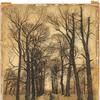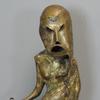Groundbreaking Exhibition on Mid-Century Corporate Design to Open at Cantor
- STANFORD, California
- /
- February 03, 2017
Creativity on the Line: Design and the Corporate World, 1950–1975
April 26–August 21, 2017
A major exhibition on view this spring at the Cantor Arts Center presents a fascinating new perspective on the creation and production of mid-century modern design. Creativity on the Line: Design and the Corporate World, 1950–1975, explores the groundbreaking work of major American designers such as Eliot Noyes and Paul Rand (for IBM and Westinghouse), Charles and Ray Eames (for Herman Miller) and Ivan Chermayeff (for Mobil Oil). European designers, including Ettore Sottsass and Marcello Nizzoli (for Olivetti) and Dieter Rams (for Braun), are also represented.
While these designers have been highly regarded for their innovations in classic works of modern design, this exhibition and its accompanying catalogue instead focus on the relationship between the designers of the 1950s, ’60s and early ’70s and top management in the large corporations for which they worked. On display are some of the highly prized objects created by these designers, including Eliot Noyes’s Selectric Typewriter for IBM and Lester Beall’s logos for Caterpillar. Quotes are extensively used to illustrate the designers’ fear of “selling out” to commerce.
The richly illustrated catalogue accompanying the exhibition includes scholarly essays that expand on subjects related to the exhibition’s main theme. An essay by Wim de Wit, Adjunct Curator of Architecture and Design at the Cantor Arts Center and curator of the exhibition, examines the ambivalence of graphic and industrial designers in their relations with the corporate world. Contributor Greg Castillo, Associate Professor of Architecture in the College of Environmental Design at UC Berkeley, places the work of post-war designers in the larger cultural and political context of the Cold War and of the developing counterculture of the late 1960s and early ’70s. Louise Mozingo, Professor and Chair of Landscape Architecture & Environmental Planning and Urban Design in the College of Environmental Design at UC Berkeley, writes about corporate directors who hired prominent architects to make their office buildings look modern, but then asked landscape designers to soften the seemingly stark architectural effect. The book concludes with an essay by Steven McCarthy, Professor in the College of Design at the University of Minnesota, about design education at Stanford University in the post-war period. Profiles of the major designers and corporations represented in the exhibition are also included.
Information: 650-723-4177, museum.stanford.edu.







![Peter Paul Rubens (Flemish, 1577–1640), After Titian (Tiziano Vecelli) (Italian [Venetian], c. 1488–1576), Rape of Europa, 1628–29. Oil on canvas, 71 7/8 x 79 3/8 in. Peter Paul Rubens (Flemish, 1577–1640), After Titian (Tiziano Vecelli) (Italian [Venetian], c. 1488–1576), Rape of Europa, 1628–29. Oil on canvas, 71 7/8 x 79 3/8 in.](/images/c/e2/2e/Jan20_Rape_of_Europa100x100_c.jpg)




![Offering a Truce [Bested], 1895, is estimated to sell for between $1,300,000 and $1,800,000 on March 22, 2014, for The Russell: An Exhibition and Sale to Benefit the C.M. Russell Museum. Offering a Truce [Bested], 1895, is estimated to sell for between $1,300,000 and $1,800,000 on March 22, 2014, for The Russell: An Exhibition and Sale to Benefit the C.M. Russell Museum.](/images/c/a8/20/Dec10_Offering_a_Truce__Bested_300dpi100x100_c.jpg)


